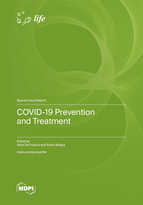COVID-19 Prevention and Treatment
A special issue of Life (ISSN 2075-1729). This special issue belongs to the section "Epidemiology".
Deadline for manuscript submissions: closed (21 November 2022) | Viewed by 97576
Special Issue Editors
Interests: pharmacology; sex and gender medicine; pharmacokinetics; pharmacodynamics; pharmacogenomics; personalized therapy
Special Issues, Collections and Topics in MDPI journals
Interests: sex and gender pharmacology; gender medicine; pharmacokinetics; pharmacogenomics; personalized therapy
Special Issues, Collections and Topics in MDPI journals
Special Issue Information
Dear Colleagues,
What started as a cluster of patients with a mysterious respiratory illness in December 2019 was later identified as COVID-19. The pathogen of severe acute respiratory syndrome coronavirus 2 (SARS-CoV-2), a novel Betacoronavirus, was subsequently isolated as the causative disease agent. Within a few months, the world experienced a pandemic. However, we have viewed the cause of this crisis only as an infectious disease. All of our interventions have focused on cutting lines of viral transmission, thereby controlling the spread of the pathogen. The science approach that has guided governments has been driven mostly by epidemic modelers and infectious disease specialists, who understandably frame the present health emergency in centuries-old terms of the plague. However, what we have learned thus far tells us that the story of COVID-19 is not so simple. COVID-19 is not a pandemic: it is a syndemic. The syndemic nature of the threat we face means that a wider approach is needed if we really want to protect the health of our communities. This Special Issue arises from the need for a new approach both in the clinical setting and in therapeutic regimens, sharing results from clinical and preclinical studies, in order to enlighten some aspects of the difficult story of COVID-19.
Original research articles, reviews, and short reports on various aspects of COVID-19 are welcome, in order to create an interdisciplinary consensus in a new perspective.
Dr. Silvia De Francia
Dr. Sarah Allegra
Guest Editors
Manuscript Submission Information
Manuscripts should be submitted online at www.mdpi.com by registering and logging in to this website. Once you are registered, click here to go to the submission form. Manuscripts can be submitted until the deadline. All submissions that pass pre-check are peer-reviewed. Accepted papers will be published continuously in the journal (as soon as accepted) and will be listed together on the special issue website. Research articles, review articles as well as short communications are invited. For planned papers, a title and short abstract (about 100 words) can be sent to the Editorial Office for announcement on this website.
Submitted manuscripts should not have been published previously, nor be under consideration for publication elsewhere (except conference proceedings papers). All manuscripts are thoroughly refereed through a single-blind peer-review process. A guide for authors and other relevant information for submission of manuscripts is available on the Instructions for Authors page. Life is an international peer-reviewed open access monthly journal published by MDPI.
Please visit the Instructions for Authors page before submitting a manuscript. The Article Processing Charge (APC) for publication in this open access journal is 2600 CHF (Swiss Francs). Submitted papers should be well formatted and use good English. Authors may use MDPI's English editing service prior to publication or during author revisions.
Keywords
- COVID-19
- therapies
- drug repurposing
- tailored treatment
- personalized medicine
Benefits of Publishing in a Special Issue
- Ease of navigation: Grouping papers by topic helps scholars navigate broad scope journals more efficiently.
- Greater discoverability: Special Issues support the reach and impact of scientific research. Articles in Special Issues are more discoverable and cited more frequently.
- Expansion of research network: Special Issues facilitate connections among authors, fostering scientific collaborations.
- External promotion: Articles in Special Issues are often promoted through the journal's social media, increasing their visibility.
- Reprint: MDPI Books provides the opportunity to republish successful Special Issues in book format, both online and in print.
Further information on MDPI's Special Issue policies can be found here.








